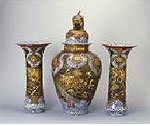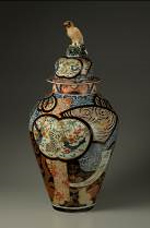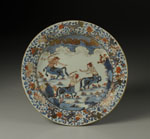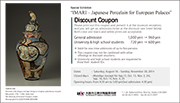SET OF A LARGE JAR AND PAIRED LARGE TRUMPET-MOUTHED VASES
Blue-and-white with applied takamaki-e (raide laquer sprinkled with gold powder) decoration of peoniEdo period, 1700 – 1740s, Arita ware
The Kyushu Ceramic Museum
The covered jar with a height of over 80 centimeters is one of the largest works of the eighteenth century. Conservations made in the past reveal that the takamaki-e decoration was fired unglazed. The surface is covered with a decoration of lions and peonies, symbols of wealth and fame, in two different techniques: underglaze blue and takamaki-e, delivering an atmosphere of magnificent splendor. The lion –shaped knob of the lid of the large jar is made out of wood and, according to a recent study, the lacquer decoration is thought to have been applied in Nagasaki.





















